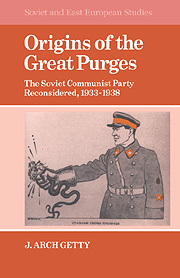Book contents
- Frontmatter
- Contents
- List of tables
- Preface
- Introduction: the Great Purges as history
- 1 The Communist Party in the thirties
- 2 What was a purge?
- 3 The Verification of Party Documents of 1935: a case study in bureaucratic ineptitude
- 4 Radicalism and party revival
- 5 Radicalism and enemies of the people
- 6 The crisis matures: 1937
- 7 Epilogue: the Ezhovshchina
- Conclusion: some observations on politics in the thirties
- Appendix: the Kirov assassination
- Bibliographic essay
- Notes
- Index
- SOVIET AND EAST EUROPEAN STUDIES
6 - The crisis matures: 1937
Published online by Cambridge University Press: 23 September 2009
- Frontmatter
- Contents
- List of tables
- Preface
- Introduction: the Great Purges as history
- 1 The Communist Party in the thirties
- 2 What was a purge?
- 3 The Verification of Party Documents of 1935: a case study in bureaucratic ineptitude
- 4 Radicalism and party revival
- 5 Radicalism and enemies of the people
- 6 The crisis matures: 1937
- 7 Epilogue: the Ezhovshchina
- Conclusion: some observations on politics in the thirties
- Appendix: the Kirov assassination
- Bibliographic essay
- Notes
- Index
- SOVIET AND EAST EUROPEAN STUDIES
Summary
This party apparat, which should be helping the party, not infrequently puts itself between the party masses and party leaders, and still further increases the alienation of the leaders from the masses.
E. M. Iaroslavskii, 1937The year 1937 saw the February plenum of the Central Committee, which “raised inner-party democracy to new heights.” It saw the fall of the entire leadership of the Western Region at nearly the same time as the first genuine party elections in many years. Several radical currents merged in the course of the year to produce a major political upheaval. The February 1937 plenum of the Central Committee is a good place to begin, for the meeting dealt with the radical campaigns of both Ezhov and Zhdanov and saw two rare speeches by Stalin on these matters.
The February 1937 plenum of the Central Committee
According to the laconic announcement of the plenum, the meeting discussed “economic and party construction” and “anti-party activities of Bukharin and Rykov,” but no resolutions were forthcoming on these subjects. As one expert pointed out, “the particulars of the proceedings remain mysterious to a substantial extent.” Although the details are still obscure, it is known that the plenum lasted ten working days rather than the usual three to five.
Of the five known speeches at the meeting (two by Stalin and one each by Ezhov, Molotov, and Zhdanov), only Zhdanov's was immediately published. Stalin's two speeches, in a unique departure, were published on page two of Pravda after a month's delay. Molotov's speech was published in edited form three weeks after that.
- Type
- Chapter
- Information
- Origins of the Great PurgesThe Soviet Communist Party Reconsidered, 1933–1938, pp. 137 - 171Publisher: Cambridge University PressPrint publication year: 1985



